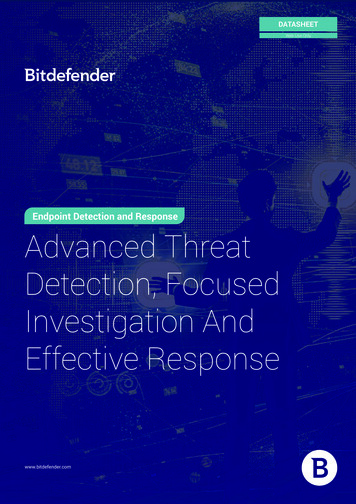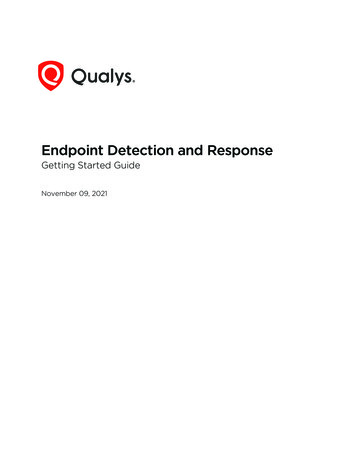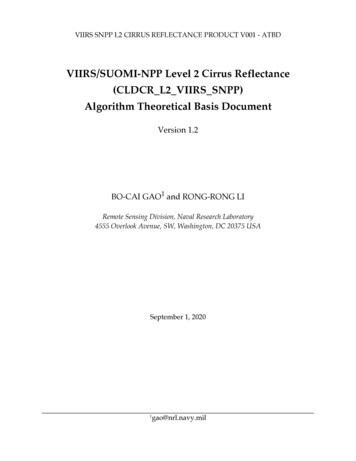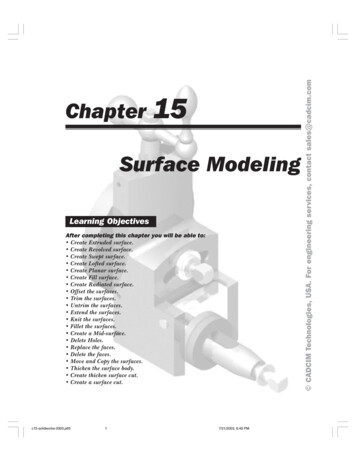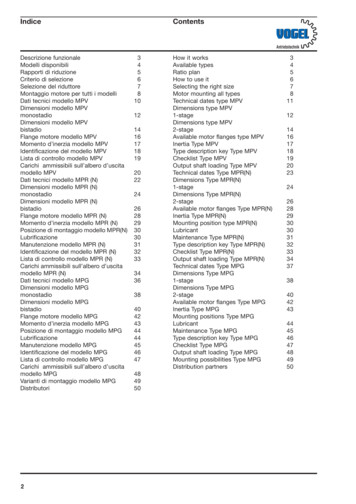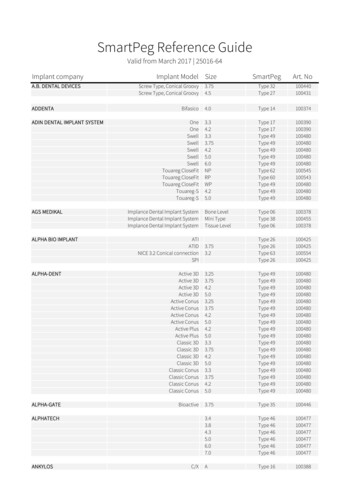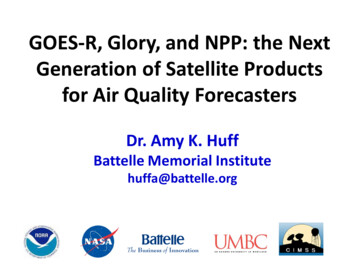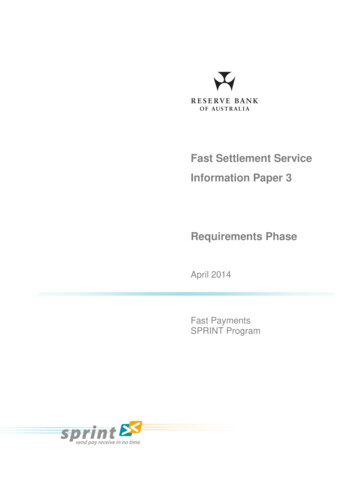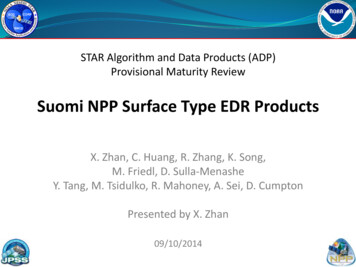
Transcription
STAR Algorithm and Data Products (ADP)Provisional Maturity ReviewSuomi NPP Surface Type EDR ProductsX. Zhan, C. Huang, R. Zhang, K. Song,M. Friedl, D. Sulla-MenasheY. Tang, M. Tsidulko, R. Mahoney, A. Sei, D. CumptonPresented by X. Zhan09/10/2014
Presentation Outline Overview of Surface Type EDR Development of 1st VIIRS QST IP 1st VIIRS QST IP compared with MODIS products Summary and future plan
VIIRS Surface Type EDR Team Xiwu Zhan (NOAA/NESDIS/STAR) Surface Type EDR team lead, User outreach Chengquan Huang (UMD/Geography) Algorithm development lead Rui Zhang/Kuan Song (UMD/Geography) Algorithm development QST Product generation User readiness Mark Friedl (Boston University) Cal/Val lead Damien Sulla-Menashe (Boston University) Ground truth data development Product validation MODIS land cover products as QST IP seed3
User Needs for Surface Type Products Essential Climate Variable Modeling studies (Primary user: NCEP land team led by M. Ek) Land surface parameterization for GCMsBiogeochemical cyclesHydrological processes Carbon and ecosystem studies Carbon stock, fluxesBiodiversity Feed to other VIIRS products BRDF/Albedo Land surface temperature (LST) Surface type change monitoring Snow cover Burned area (TBD) Flooding/deforestation/etc (TBD)4
L1RD Requirements*** Current IDP product was designed to meet heritage NPOESS requirements. Beta evaluation is done againstthose heritage requirements. Precision and accuracy numbers are to be corrected in the JPSS L1RD.5
Existing Global Surface Type ProductsProductSensorResolutionData RIS300 m2005Classificationand labeling73%Defourny et al.,2007MODIS LCCollection 5MODIS500 m2005Decision tree74.8%Friedl et al.,2010MODIS LCCollection 4MODIS1 km2001Decision tree 75%Friedl et al,2002DISCoverAVHRR1 km1992.4-1993.3Clusteringand labeling66.9%Scepan, 1999UMD-1kmAVHRR1 km1992.4-1993.3Decision tree69%(training)Hansen etal., 2000GLC2000SPOT-VEGETATION1 km1999.112000.12Regionalexperts68.6%Mayaux etal., 20066
Overview of VIIRS Surface Type EDR Describes surface condition at time of each VIIRS overpass Produced for every VIIRS swath/granule Same geometry as any VIIRS 750m granule Two major components Gridded Quarterly Surface Type (QST) IP Remapped to the swath/granule space for each VIIRS acquisition Requires one full year of VIIRS data Just developed, subject of this review Includes flags to indicate snow and fire based on Active fire Application Related Product (ARP) Snow EDR Vegetation Fraction is included, but will be replaced by NDR GVF7
History of ST EDR Related DRsDateDR #ReasonStatus11/18/20114452ST rename vegetation fractionNDE provides separate GVF product in future11/18/20114458C5 Decision tree replacementUMD to upgrade QST IP algorithm with SVM infuture11/18/20114459QST IP goes to annualTo be approved in future05/22/20124707Update QST IP seed dataCompleted with MODIS C5 LC09/12/20124900Remove new QST IP Seed fill valuesCompleted with update MODIS C5 LC01/14/20137002ST EDR Beta reviewCompleted, with a focus on ST EDR03/20137090ST EDR update for use of snow rolling tileApproved, DPE implemented09/20137329ST EDR controller cores without optionalinput VCMChanged VCM to required input10/20137549ST EDR Vegetation Fraction fill valueChanged to produce VF only for clear sky withoutaerosol impact01/20147522Update IDPS with new VIIRS QST-IP/QST- Test data from Mx8.4 indicates installation of thenew QST-IP/QST-LWM tiles successful 8LWM (CCR 1700)
Current Status of Surface Type EDR Provisional maturity science review done in Jan 2014: 1st VIIRS QST IP (gridded) based on pure VIIRS 2012 datawas generated; Preliminary quality check indicates reasonable quality Improvements since beta review: Change snow fraction from 0.75 to 0.5 in aggregating SnowEDR from 375m to 750m before being copied to SurfaceType EDR Use rolling tile snow products when VIIRS Snow EDR notavailable Vegetation fraction fill value issues addressed Mx8.4 test data indicated that new VIIRS QST-IP/QST-LWMhas been correctly installed in IDPS9
What to look for in this review Development of VIIRS QST IP VIIRS data processing Gridding Compositing Annual metrics generation Training data collection Classification QST IP assessment Comparison with MODIS Collection5 Mx8.4 test data evaluation Next steps10
VIIRS QST IP Overview Global surface type product Gridded, 1km 17 IGBP surface type classes Required typing accuracy 70% Generated quarterly to reflect recent changes Based on gridded surface reflectance products (IDPSversion still being evaluated) Use decision tree (C5.0) classifier Requires training data11
Surface Types inQST IPClasses separated by athreshold value more likelyto be confused:Closed vs open shrublandsForest vs woody savanna vssavannaCropland vs cropland/naturalvegetation mosaics12
Data Flow of QST IP AlgorithmVIIRS surfacereflectance data(swath)VIIRS Gridded MonthlySurface Reflectance IPVIIRS Gridded MonthlyVegetation Index RS Gridded MonthlyBrightness Temperatures IPTemporalMetricsCompositingGlobal composites(daily)CompositingPast Yearly Values ofMax, Min ofMonthly NDVITemporalMetricsGriddingGridded surfacereflectance dataWriteYearlyNDVIValuesDEMSystemTimeTraining nthsDone?NoWaitUntilNextPassDecision TreeApplyDecisionTreeSurfaceTypeson gridWriteQuarterlySurfaceTypes IPVIIRS QuarterlySurface Types IPAggregateIGBPClassesBiome typeson gridWriteSurfaceTypes-BiomesIPVIIRS SurfaceTypes-Biomes IP13
Overview of QST IP Algorithm and ProductAssessment ApproachesVIIRS surfacereflectance data(swath)GriddingGridded surfacereflectance dataCompositingGlobal composites(daily)Training sampleDecision treeSupport vectormachines (SVM)Validation dataVIIRS QST IPproductCompositingGlobal composites(32-day)Metrics generationOther surface typeproductsAnnual metrics(global)14
Gridding, Compositing, Annual Metrics(GCAM) OverviewVIIRS surfacereflectance data(swath)GriddingGridded surfacereflectance dataCompositingGlobal composites(daily)CompositingGlobal composites(32-day)Metrics generationAnnual metrics(global) Required before classification Remove cloud/shadow Annual metrics globally moreconsistent Should be done by IDPS, butgridded data not available untilrecently processed in-house at UMD Improvements possible Composites comparable to orbetter than MODIS composites15
Gridding Done in house at UMD No gridded data from IDPS until late 2012 Solution provided by Land PEATE MODIS like VIIRS data (5-minutes aggregation)Gridding tool Fully automated downloading and gridding scripts All 2012 VIIRS data required by QST IP processed 880,000 files (80,000 granules x 11 bands), totaling 150 TB 30,000 CPU hours16
Global Mosaics of Gridded Daily Data2012-0212012-1122012-2002012-29517
Compositing Required for reducing cloud/shadow contamination MODIS algorithm: “best” quality Requires good quality flags and cloud mask Surface Type ATBD algorithm: Controlled View Angle Max NDVI Max NDVI has many known issuesTends to choose off-nadir view observations Cloud selected over water Problematic over non-vegetated areas Improved Max NDVI Compositing priority: vegetated soil water snow cloud 18
VIIRS Composites Comparable with StandardMODIS Composites (MOD09A1)MODIS tile H12v04 (New York to Great lakes), 8-day (2012/193-200)Better composites over waterVIIRS, M11-7-5MODIS, B7-2-119
More Comparison with MODIS CompositesH12v04 (western China)2012/193-200Less snow pixelsselectedH12v10 (Brazil, Arc ofDeforestation)2012/193-200Less artifacts (swathboundary)VIIRS, M11-7-5MODIS, B7-2-120
Cloud ReductionthroughCompositing8-day (2012/193-200)Daily (2012/200)32-day (2012/193-224)21
Global Mosaics of 32-day -32022
Use of Annual Metrics Based on metrics developed by Hansen et al for AVHRR landcover and MODIS VCF Further cloud removal in the 32-day composites Normalize differences between the northern and southernhemisphere Better reflect vegetation phenology and other surfacecharacteristics Some metrics could be sensitive to residual clouds in the 32-daycomposites23
Annual Metrics from VIIRS– 2012 Median NDVI24
VIIRS 2012 Growth Season NDVI Variation00.825
Median of the Three Warmest 32-day Composites(M11, M7, M5 in RGB)26
Late Spring (97-128) 32-day Composite27
Annual Metrics (76 Total) Used NDVI Metrics: Second maximum monthly NDVI in a year Minimum NDVI value in the highest 7 monthly NDVIs Median NDVI in the highest 7 monthly NDVIs Range of NDVI in the highest 7 monthly NDVIs Median NDVI in the 5 warmest months NDVI of the warmest month Reflectance Metrics (VIIRS M bands 3-8, 10, 11, 15): Second maximum reflectance, during the 7 greenest in the year Minimum reflectance, during the 7 greenest months Median reflectance of the 7 greenest months Range of reflectance, among the 7 greenest months Median reflectance of the 5 warmest months Reflectance of the month with the second highest NDVI in the year Reflectance of the warmest month28
Training Data DistributionClass Training 1117912373913145791531416674These training points were provided byBoston University, in 500m resolution.They were majority-sampled into 1000mresolution for VIIRS classificationLand Cover in LouisianaLand Cover in CATraining pixelsTraining pixels29
Classification Algorithm – Decision TreeX a? Easy-to-understand decision rules Improved accuracy throughNYensemble (boosting) Robust for global applications Base algorithm for several existingglobal surface type products(Hansen et al., 2000; Friedl et al.,2002; 2010) Specified in ATBD30
Decisions Made Based on Information Theory For each variable, try all possible ways to split the training samples For each split, calculate the following:kInfo(T ) j 1 Cj log 2 T TCj nTii 1TInfo X (T ) Info(Ti )Gain( X ) Info(T ) Info X (T ) Ti log 2 Split Info( X ) i 1 T T Gain Ratio( X ) Gain( X ) / Split Info( X )nTi– The selected split maximizes the Gain Ratio– Different DT algorithms may use differentcriteria– Applied recursively31
First VIIRS QST IP from 2012 VIIRS Data32
Comparison with MODIS Land Cover Products MODIS Collection 4 (C4) land cover product Derived using annual MODIS data Decision tree Reported accuracy: 75% Initial seed in IDPS MODIS Collection 5 (C5) product Derived using multi-year MODIS data Decision tree Post-classification process Use class prior probability Reported accuracy: 74.8% Currently used as seed in IDPS33
Comparison withMODIS C4/C5 LCVIIRS QST IPMODIS C4 LC34MODIS C5 LC
Detailed Comparisons35
Validation Sample DesignEach sample block (black squares) containsbetween 10 and 35 1-km VIIRS pixels.36
Illustration of ValidationInterpretation Protocol2004Full validation block in GoogleEarthTMwith sample pixel highlighted in red.Sample VIIRS pixel for twodifferent years 2007 and 2011.Change (deforestation) identified from MODIS timeseries as occurring for sample pixel (right) in 2007.201137
Interpretation Status for 500 blocksWe have completed 260 of the 500 sample blocks (red points).38
MODIS SeedIGBP LegendVIIRS39
70% Accuracy ThresholdThere is more variance in overall accuracies acrossaggregation levels than between maps.40
41
42
43
North America – Accuracies by StratumFive Class LegendFull Legend44
Australia – Accuracies by StratumFull LegendFive Class Legend45
MODIS SeedIGBP LegendVIIRS46
Qualitative Comparison of the Two MapsClass confusion between the MODIS Seed and the VIIRS map is assessed from arandom sample of 60,000 1km land pixels. Total percent agreement is 76%.47
Alaska, USAMODIS SeedVIIRS48
Johannesburg – South AfricaMODIS SeedVIIRS49
Southern India and Sri LankaMODIS SeedVIIRS50
Southwestern USAMODIS SeedVIIRS51
Caucasus Mountains - RussiaMODIS SeedVIIRS52
Northeastern USAMODIS SeedVIIRS53
Beijing - ChinaMODIS SeedVIIRS54
Recap from Assessment1. The new VIIRS QST map compares favorably tothe MODIS QST Seed.2. Most of the class confusion and uncertainty ineither map can be explained by spectrallysimilar or poorly defined IGBP classes.3. With some modest improvements, theaccuracy of the VIIRS QST map will exceed thatof the MODIS Seed.55
CCR1700 Surface Type EDR Test ResultsVisual Comparisons among Surface type EDR inCCR 1700 test data, IDPS QST-IP data (CCR 692),and UMD delivered QST-IP data suggest that thenew VIIRS based QST-IP has been indeedsuccessfully implemented in the new CCR 1700test data.
North AmericaUMD Delivered QST-IPST EDR in CCR 1700IDPS QST-IP (CCR692)
South AmericaUMD Delivered QST-IPST EDR in CCR 1700IDPS QST-IP (CCR692)
EuropeUMD Delivered QST-IPST EDR in CCR 1700IDPS QST-IP (CCR692)
AsiaUMD Delivered QST-IPST EDR in CCR 1700IDPS QST-IP (CCR692)
Surface Type Provisional Status Summary ST EDR Operational algorithm (IDPS) validated Issues identified and addressed Further improvements possible with Improvements to Fire, Snow, and other VIIRS productsUpdates to QST IPTimely detection of major land cover change processes: flooding,burn scar, large scale deforestation61
Surface Type Provisional Status Summary QST IP In-house implementation of ATBD algorithms successful Gridding/compositing/annual metrics (GCAM)Classification Newly collected training data Original training data were of limited use (error, out of date,undesirable distribution)New data from BUAdditional data collected by UMD First QST IP produced using 2012 VIIRS data Quality likely close to MODIS land cover products62
Provisional Consideration and Future Plan Gridding/compositing/annual metrics (GCAM) huge job Better done on systems with lots of CPU, bandwidth, and storage space Compositing and annual metrics have room to improve Especially over sparsely or non-vegetated surfaces Better cloud removal Residual clouds apparent in some areas Usefulness of some metrics questionable Better compositing algorithm can help (e.g., use QA flags/cloud masks) Use multi-year data 2-years VIIRS data already exist Can add MODIS data63
Provisional Consideration and Future Plan Training data improvement More representative Timely update of changes Classification algorithm improvements SVM generally more accurate than DT Post-classification improvements (e.g., BU’s approach of incorporatingclass probability in MODIS C5)64
Provisional Consideration and Future Plan Take advantage of additional bands 375m imagery bands allow better estimation of subpixel cover DNB useful urban More comprehensive assessment Better use of freely available high resolution data (e.g. GoogleEarth, Landsat)65
Use rolling tile snow products when VIIRS Snow EDR not . MODIS tile H12v04 (New York to Great lakes), 8- day (2012/193-200) Better composites over water : VIIRS, M11-7-5 MODIS, B7-2-1 20 H12v04 (western China) 2012/193-200 Less snow pixels selected H12v10 (Brazil, Arc of

